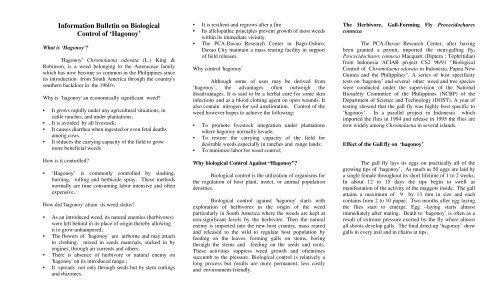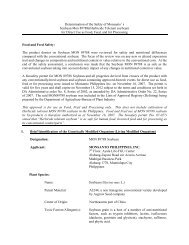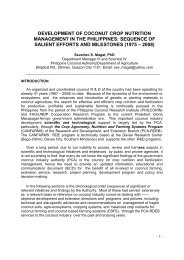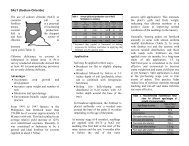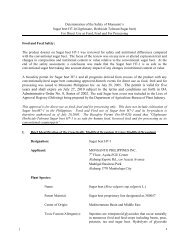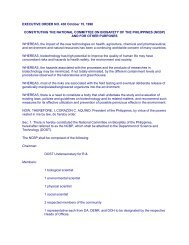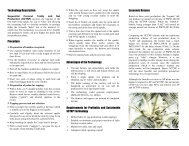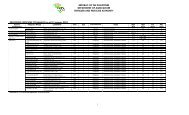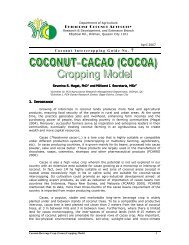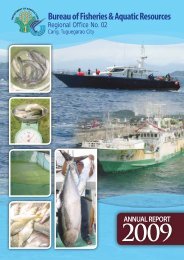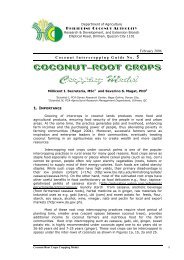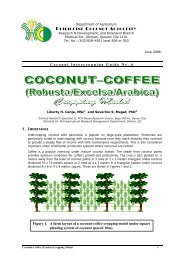Hagonoy - Philippine Coconut Authority
Hagonoy - Philippine Coconut Authority
Hagonoy - Philippine Coconut Authority
Create successful ePaper yourself
Turn your PDF publications into a flip-book with our unique Google optimized e-Paper software.
Information Bulletin on Biological<br />
Control of ‘<strong>Hagonoy</strong>’<br />
What is ‘<strong>Hagonoy</strong>’?<br />
'<strong>Hagonoy</strong>' Chromolaena odorata (L.) King &<br />
Robinson, is a weed belonging to the Asteraceae family<br />
which has now become so common in the <strong>Philippine</strong>s since<br />
its introduction from South America through the country's<br />
southern backdoor in the 1960's.<br />
Why is 'hagonoy' an economically significant weed?<br />
• It grows rapidly under any agricultural situations, in<br />
cattle ranches, and under plantations;<br />
• It is avoided by all livestock;<br />
• It causes diarrhea when ingested or even fetal deaths<br />
among cows.<br />
• It reduces the carrying capacity of the field to grow<br />
more beneficial weeds<br />
How is it controlled?<br />
• ‘<strong>Hagonoy</strong>’ is commonly controlled by slashing,<br />
burning, rolling and herbicide spray. These methods<br />
normally are time consuming labor intensive and often<br />
expensive.<br />
How did 'hagonoy' attain its weed status?<br />
• As an introduced weed, its natural enemies (herbivores)<br />
were left behind in its place of origin thereby allowing<br />
it to grow unhampered;<br />
• The flowers of 'hagonoy' are airborne and may attach<br />
to clothing, mixed in seeds materials, sucked in by<br />
engines, through air currents and others;<br />
• There is absence of herbivore or natural enemy on<br />
'hagonoy' on its introduced range.;<br />
• It spreads not only through seeds but by stem cuttings<br />
and rhizomes.<br />
• It is resilient and regrows after a fire<br />
• Its allelopathic principles prevent growth of most weeds<br />
within its immediate vicinity.<br />
• The PCA-Davao Research Center in Bago-Oshiro,<br />
Davao City maintain a mass rearing facility in support<br />
of field releases.<br />
Why control 'hagonoy'<br />
Although some of uses may be derived from<br />
‘hagonoy’, the advantages often outweigh the<br />
disadvantages. It is said to be a herbal cure for some skin<br />
infections and as a blood clotting agent on open wounds. It<br />
also contain nitrogen for soil amelioration. Control of the<br />
weed however hopes to achieve the following:<br />
• To promote livestock integration under plantations<br />
where hagonoy normally invade;<br />
• To restore the carrying capacity of the field for<br />
desirable weeds especially in ranches and range lands;<br />
• To minimize labor for weed control;<br />
Why biological Control Against “<strong>Hagonoy</strong>”?<br />
Biological control is the utilization of organisms for<br />
the regulation of host plant, insect, or animal population<br />
densities.<br />
Biological control against 'hagonoy' starts with<br />
exploration of herbivores in the origin of the weed<br />
particularly in South America where the weeds are kept at<br />
non-significant levels by the herbivore. Then the natural<br />
enemy is imported into the new host country, mass reared<br />
and released to the wild to regulate host population by<br />
feeding on the leaves, forming galls on stems, boring<br />
through the stems and feeding on the seeds and roots.<br />
These activities suppress weed growth and oftentimes<br />
succumb to the pressure. Biological control is relatively a<br />
long process but results are more permanent, less costly<br />
and environment-friendly.<br />
The Herbivore, Gall-Forming Fly Procecidochares<br />
connexa<br />
The PCA-Davao Research Center, after having<br />
been granted a permit, imported the stem-galling fly,<br />
Procecidochares connexa Macquart (Diptera : Tephritidae)<br />
from Indonesia ACIAR project CS2 96/91 "Biological<br />
Control of Chromolaena odorata in Indonesia, Papua New<br />
Guinea and the <strong>Philippine</strong>s". A series of host specificity<br />
tests on ‘hagonoy’ and several other weed and tree species<br />
were conducted under the supervision of the National<br />
Biosafety Committee of the <strong>Philippine</strong>s (NCBP) of the<br />
Department of Science and Technology (DOST). A year of<br />
testing showed that the gall fly was highly host specific to<br />
‘hagonoy’. In a parallel project in Indonesia which<br />
imported the flies in 1994 and release in 1995 the flies are<br />
now widely among Chromolaena in several islands.<br />
Effect of the Gall fly on ‘hagonoy’<br />
The gall fly lays its eggs on practically all of the<br />
growing tips of ‘hagonoy’. As much as 50 eggs are laid by<br />
a single female throughout its short lifetime of 1 to 2 weeks.<br />
In about 12 to 15 days the tips begin to swell as<br />
manifestation of the activity of the maggots inside. The gall<br />
attains a maximum of 9 by 13 mm in size and each<br />
contains from 2 to 10 pupae. Two months after egg laying<br />
the flies start to emerge. Egg –laying starts almost<br />
immediately after mating. Death to ‘hagonoy’ is often as a<br />
result of extreme pressure exerted by the fly where almost<br />
all shoots develop galls. The final dried-up ‘hagonoy’ show<br />
galls in every axil and in chains at tips.
CPD TECHNOGUIDE NO. 8<br />
Series of 2003<br />
A Healthy Chromolaena<br />
odorata thicket<br />
The gally fly adult male<br />
(left), female (right)<br />
A rich harvest of the galls for<br />
fly emergence inside<br />
laboratory<br />
A portion of a ‘hagonoy’<br />
stem which died of die back<br />
due to gall pressure<br />
PRIMER ON<br />
BIOLOGICAL CONTROL OF<br />
HAGONOY (Chromolaena<br />
odorata)<br />
An adult female laying egg<br />
on host tip<br />
Initial galling in 12 to 15days<br />
FOR ADDITIONAL INFORMATION<br />
Call, write or visit:<br />
The Crop Protection Division<br />
Davao Research Center<br />
<strong>Philippine</strong> <strong>Coconut</strong> <strong>Authority</strong><br />
Bago-Oshiro, Mintal<br />
An enlarged gall containing<br />
from 2 to 10 gall fly larvae<br />
Pupae of the gall fly<br />
Tugbok District, Davao City<br />
Tel. No. (082) 293-0116<br />
(082) 293-0119<br />
Fax No. (082) 293-0571<br />
E-mail : pca-cpd@mozcom.com<br />
pca-asd@mozcom.com<br />
Crop Protection Division<br />
Davao Research Center<br />
Agricultural Research &<br />
Development Branch<br />
<strong>Philippine</strong> <strong>Coconut</strong> <strong>Authority</strong><br />
Bago-Oshiro, Davao City


